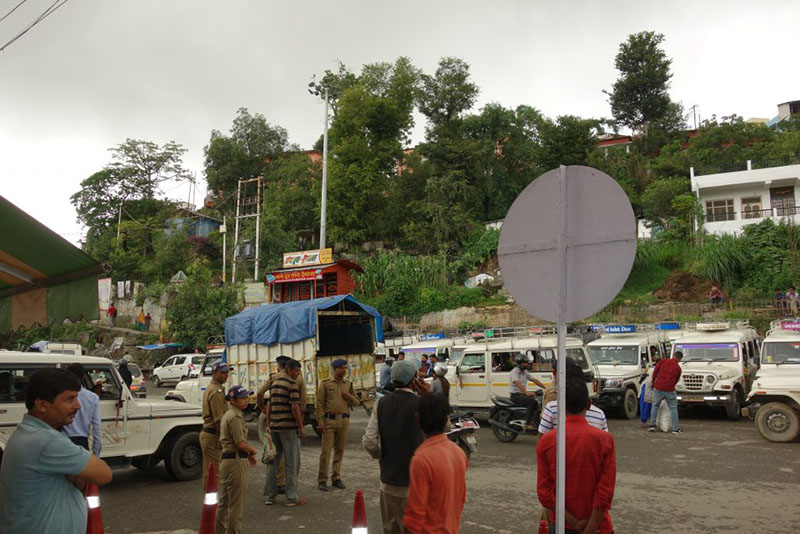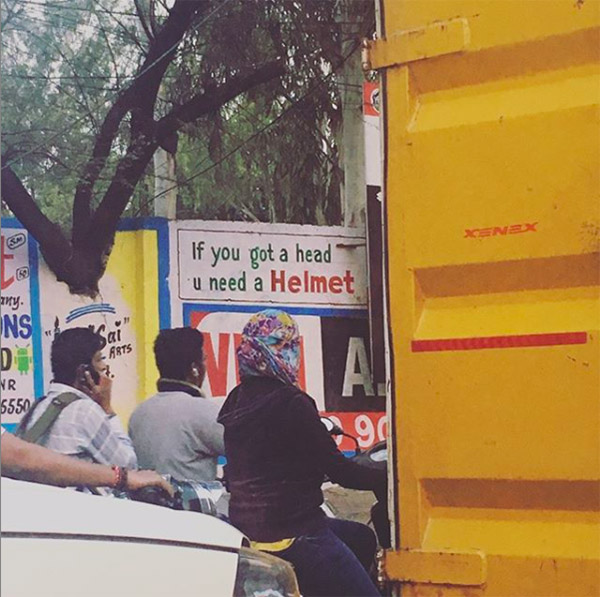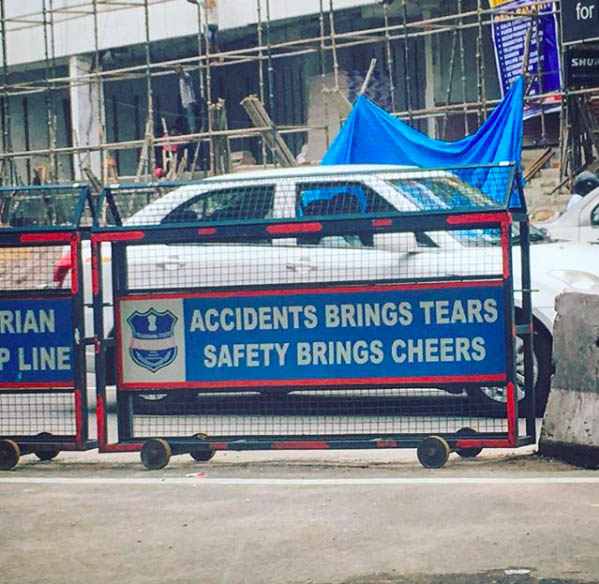One of the first things that gets discussed with reference to India is road traffic. Erstwhile known as a land of snake charmers, this classically orientalist image of the country has been displaced by a more technocratic obsession with road traffic and accidents[1]. While debates amongst the educated elite around the “appropriate” use of roads have been ongoing since the early colonial period[2], it is only more recently that road safety has begun to garner palpable urgency in its visibility as a social problem that needs to be solved by the Indian state. As such, with the United Nations declaring 2010-2020 as the ‘Decade for Action on Road Safety’, international pressure on the Global South to adopt road safety has only intensified[3].
The Indian government’s tightening of legal, institutional, and financial measures focusing on traffic is most recently expressed in the form of a major amendment to the colonial-era[4] Motor Vehicle Act (MVA). On September 1, 2019, the government put in effect revisions made by the Parliament to sixty-three clauses under this act. Of these, the most controversial revisions were the steep increases in penalties for traffic violations. One national newspaper proclaimed that this punitive agenda “will change the way India drives.” While the changes in the law are more encompassing than just a hike in fines, it has been the centerpiece of public discussion. Most of these have focused around a moral discourse – one that highlights the dire need for a law that can protect citizens from themselves and each other. The state, in leading the way towards “safer roads”, has taken on the role of a caring parent: we need to penalize you for your own safety. This pedagogical benevolence of the postcolonial state is neatly tucked beneath the cloak of punishment; the first step, it seems, in making the obligatory desirable is making the obligatory obligatory.

Poster Competition among for high school children in Bageshwar district during the road safety week organized by the police. This is a prize winning poster highlighting the provisions of the MVA 2019 that must be obeyed by driver-citizens. Photo in February 2019 by Bhoomika Joshi
As one might imagine, the revised penalties have been met with a fair dose of skepticism and resistance in the public, especially amongst working-class transport workers. Some of this suspicion is centered around the argument that an increase in fines and penalties might exacerbate corruption amongst traffic police. A related note of skepticism is also anchored in questions about whether it is fair to impose high fines on drivers and riders, since the state itself has failed to ensure bribe-free licensing procedures and pothole-free roads. Resistance has taken the form of various state governments refusing to implement high fines in their respective jurisdictions. One political leader openly denounced the law as being “too harsh,” while another politician claimed to not want to “harass” constituents. Eleven out of the twenty-eight states refused to implement the high fines[5].
A moral rhetoric that makes any criticism of the law appear to be villainous or in bad faith is clearly embedded in both public and official discourses. Both the authors of this piece have at several points been rebuked by their informants for voicing skepticism of the law with a very sharp and offended sentiment, “do you want people to die on the roads?” Keeping this in mind, perhaps it is imperative for us to clarify that we do not want people to die on the roads, or that safety does not matter to the people that we spent time with while doing fieldwork in the hilly rural areas of Kumaon and the bustling metropolis of Hyderabad.

Traffic police monitoring traffic at a busy road junction in Pithoragarh. Photo in July 2018 by Bhoomika Joshi
Instead, what we want to highlight is that the birth, celebration, and messy implementation of this law in the name of safety is not an isolated event. This law is a symptom of a larger process attempting to reformulate the relationship between the body and the machine, the citizen and the state. What the state is manufacturing is a disposition not just towards authority but respect for a certain kind of safety – one that is defined by law, by the state, and by political artifacts, like helmets and seatbelts. The law and its attempted transformation of the ‘Indian mentality’ (a term used with much flair in the country) needs to be understood in relation to a process – what we term the process of the production of technical safety.
Producing Technical Safety
In order to understand what we mean by ‘technical safety,’ it is worth attending to Latour’s discussion of seatbelts:
It has become logically—no, it has become sociologically—impossible to drive without wearing the belt. I cannot be bad anymore. I, plus the car, plus the dozens of patented engineers, plus the police are making me be moral (1992: 152, emphasis added)
Technical safety implies the prevention of injury to self and others by the appropriate use of the technologies of safety like seatbelts, helmets, insurance, traffic lights, and driver’s licenses. The assurance of safety rests with the user of such technologies. Through the demonstrable use of such technologies, the morality of the driver is transformed into the morality of a driver-citizen (Beckmann 2001; Seiler 2009) who is accountable for his safety and for the safety of others on the road. ‘Perfect driving’ is thrust as being ‘humanly possible and legally obligatory’ (Jain 2004: 66). Traffic, therefore, is strictly monitored and supervised where morality is calibrated on technology and immorality curtailed through the collection of fines and penalties. Techniques of technical safety can be manufactured in laboratories and design labs, state enactments, and financial consultancies, but technical safety is produced in the interaction of a moral citizen and the technique which the state monitors. Perfect driving hence produces perfect driver-citizens when governed by what Virilio (2005) describes as the ‘administration of fear’.

Helmets in Hyderabad. Photo by Sneha Annavarapu.
Given the discourse on road accidents in India, both nationally and internationally, the emphasis of governing traffic has been on producing safety on roads. The maxim that India’s roads ought to be made safe from the scourge of accidents drives these newly incorporated measures in the amended MVA. This sentiment is often construed in pathological terms—as a public health crisis or as an epidemic—where “traffic becomes a problem for medicine to solve” (Solomon 2017)[6]. The imposition of heavy fines and penalties in the new MVA makes the driver-citizen responsible for his own safety, the safety of other driver-citizens, plus the non-driver citizens on the road. The MVA mobilizes and moralizes traffic in the service of technical safety such that the morality of punishment embedded in penalties for violation of traffic rules produces shame for the erring driver-citizen. Traffic is hence a socio-technical system in which the driver potentially becomes both ‘logically inconceivable and morally unbearable’ (Latour 1992: 152).
Therefore, the state produces and ensures technical safety by making the driver-citizen accountable while simultaneously abdicating its own responsibility towards things like road design and maintenance, availability of emergency care, and the regulation of non-driver citizen actors. Jain’s study of injury law and American consumerist subjectivities (2006) provides us the cue to understanding how technical safety is produced through the figure of the individual driver citizen. According to Jain, tort law in USA:
fits within an individualized notion of American citizenship, understanding injury not as a structural premise of capitalism and a condition of its possibility but as an accidental side-effect – a problem that can be rectified at the level of the individual and the particular facts of her case’ (2006:3)
While American tort law is not directly comparable with the legal provisions of the MVA, it is worth noting that both the Indian driver-citizen and the American citizen are presented with the disjuncture that injury (from violation of traffic rules and product design respectively) provides. It presents a ‘rationalized and formalized arena’ (Jain 2006) for the exercise and reproduction of their citizenship. This arena is the arena of technical safety where individuals can claim safety on the roads only by producing it. ‘Drivers’ are hence produced as ‘driver-citizens’ through the reproduction of technical safety on the roads as designed and monitored by the state.

“Traffic safety slogans on road dividers”. Photo by Sneha Annavarapu
The Politics of Technical Safety
The MV Act amendments in India arrive at a time when technical solutions like toilets, helmets, and a cashless economy are being invested in through the promise of technical safety. These ‘surgical strikes’ against violations let loose a kind of fear among its citizens for not being self-aware enough about the promises sanitation, road safety, and cashlessness offer. On the road, a driver can conduct his citizenship, first and foremost, by producing technical safety in order to claim it as a driver-citizen. While mobs can lynch citizens on the highways, driver-citizens are safe from the lapses of their own rationality. The increase in fines and penalties necessitates a reimagination of one’s own disposition towards the authority and legitimacy of the state. This move towards respecting[7] the authority of the expert embedded in the physicality of objects like helmets and seatbelts requires an acceptance of a version of safety that is deemed natural and unrelated to other issues of safety and security in the country.
The unstated and unarticulated promises of the Act are, in fact, as much about the future as they are about the past. India’s aspirations and aesthetics of ‘world class’ development are inscribed in the restless anticipation for the appearance of order and the desire for seamless speed; unerring streamlined mobility (Virilio 2005) is palpable in the making of spectacular road infrastructures (Harvey and Knox 2015). Yet, the lingering presence of a colonial desire to save “the natives”[8] from themselves constitutes the very desirability of a neoliberal disposition that isolates, produces, and glorifies technical safety.
Footnotes
[1] Travelogues, movies, and books depict Indian roads as anarchic with tragicomic depictions of bikes, cars, and pedestrians all “running wild. While a cursory google search will substantiate this claim, more skeptical readers might want to take a look at the video “Incredible Indian Traffic – isn’t it crazy?!” on YouTube which has close to a million views. This video – and the very intention behind its creation – exemplifies the kinds of imaginaries and narratives Indian driving often gives rise to in public discourse
[2] Arnold, David (2012): 119-141.
[3] More recently, there has also been a surge in campaigns about road safety awareness in India. And most of these campaigns are sponsored by big international automobile manufacturers – ‘Road to Safety’, a Diageo initiative in alliance with United Spirits (2015), other initiatives supported by Mercedes Benz, Safe Roads (2015), by Shell (2015) and the Safe Move-Traffic Safety Campaign (2016) by Hyundai.
[4] that was first passed in 1914.
[5] In fact, transport workers in the capital city of New Delhi engaged in a one-day strike opposing the hefty traffic fines (among other issues).
[6] See Lamont and Lee (2015) for a consideration of the ‘epidemiological turn’ in road safety interventions in Kenya and South Africa, which are influenced by the public health constructions of the HIV/AIDS epidemic.
[7] A phrase often used to characterize the attitude of Indian drivers towards traffic rules is that they do not respect them.
[8] There is much potential here to analogize considering the colonial rhetoric behind practices of hygiene, sanitation and cleanliness in the colonies.
References
Arnold, David. “The Problem of Traffic: The street-life of modernity in late-colonial India.” Modern Asian Studies 46, no. 1 (2012): 119-141.
Beckmann, Jörg. “Automobility—a social problem and theoretical concept.” Environment and Planning D: Society and Space 19, no. 5 (2001): 593-607
Harvey, Penny, and Hannah Knox. Roads: An anthropology of infrastructure and expertise. Cornell University Press, 2015.
Jain, Sarah S. Lochlann. ““Dangerous instrumentality”: the bystander as subject in automobility.” Cultural Anthropology 19, no. 1 (2004): 61-94.
Jain, Sarah S. Lochlann. Injury: The politics of product design and safety law in the United States. Princeton University Press, 2006.
Lamont, Mark, and Rebekah Lee. “Arrive alive: road safety in Kenya and South Africa.” Technology and culture 56, no. 2 (2015): 464-488.
Latour, Bruno. “Where Are the Missing Masses? The Sociology of a Few Mundane Artifacts’’.” in Wiebe E. Bijker and John Law, eds., Shaping Technology/Building Society: Studies in Sociotechnical Change (Cambridge, Mass.: MIT Press, 1992), pp. 225–258..
Solomon, Harris. “Shifting gears: triage and traffic in urban India.” Medical anthropology quarterly 31, no. 3 (2017): 349-364.
Virilio, Paul. The original accident. Polity, 2007.
